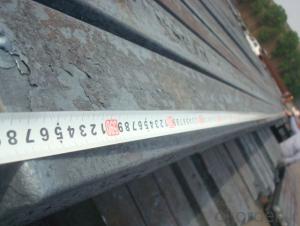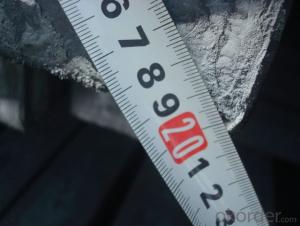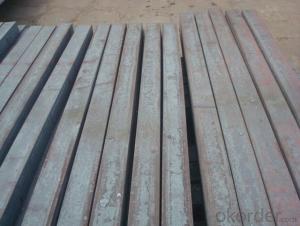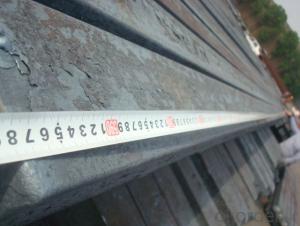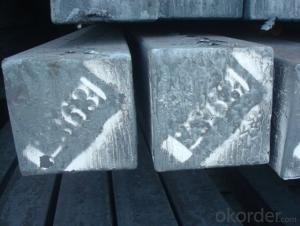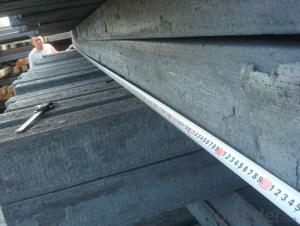Continue Casting Steel Billet/Bloom By Blasting Furnace
- Loading Port:
- Qingdao
- Payment Terms:
- TT OR LC
- Min Order Qty:
- 1000 m.t.
- Supply Capability:
- 10000 m.t./month
OKorder Service Pledge
OKorder Financial Service
You Might Also Like
Continue Casting Steel Billet/Bloom By Blasting Furnace
1.Structure of Continue Casting Steel Billet/Bloom By Blasting Furnace
Continue Casting Steel Billet Manufactured By Blasting Furnace is the raw material of all kinds of steel mill. Billet section of square, round, flat, rectangular and abnormity, etc Several, mainly related to shape of rolled products. Simple rolled section steel, choose cross section of square billet or rectangular billet. rolling The sector products such as flat steel, Angle steel, select the rectangular billet or slab. Had better profiled billet when production beams, channels, and in rolling process Lines and improve the yield. The raw material of round billet is the production of seamless tube.
2.Main Features of Continue Casting Steel Billet/Bloom By Blasting Furnace
Continue Casting Steel Billet Manufactured By Blasting Furnace section size should meet the requirements of rolling deformation and finished product quality, but also roll strength and biting condition of restrictions. General steel Billet section height H. And the roll diameter D The ratio of the ( namely H/D) Should be less than or equal to zero 0.5 . Length of steel billet by finishing temperature, Rolling time and the length of the product Or times ruler. When heated too long accident prone to bump the furnace wall of steel, too short, furnace bottom utilization rate is not high, influence the heating furnace production. For the production Choose a variety of steel and steel billet, should consider the affinities of billet, as far as possible in order to improve the productivity of the roughing mill, simplify the stock management of workshop.
3. Continue Casting Steel Billet/Bloom By Blasting Furnace Images

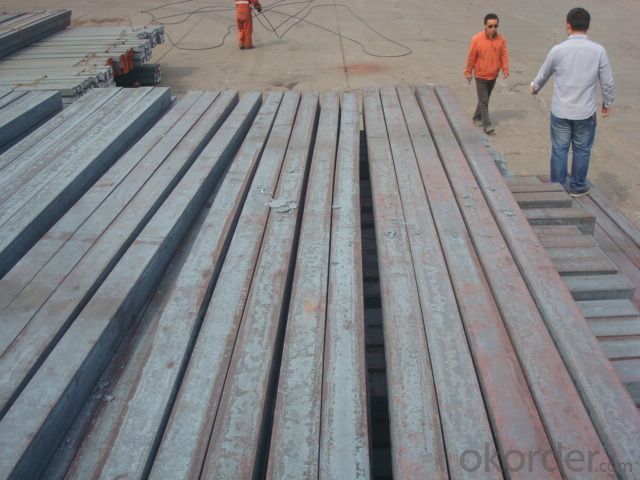
4. Continue Casting Steel Billet/Bloom By Blasting Furnace Specification
Continue Casting Steel Billet Manufactured By Blasting Furnace rolled steel, after processing can be used for mechanical parts, forging parts, processing all kinds of steel, steel Q345B channel steel, wire rod is the role of the billet. Steel billet is used in the production of semi-finished products, generally cannot be used directly for the society. Steel billets and steel are strictly divided into standard, cannot decide to whether the business enterprise of the final product, and according to unified standards to perform the whole society. Typically, billet and the steel is relatively easy to distinguish, but for some steel billet, and have the same specification and same steel purposes (such as rolling tube billet), whether can be used for other industries, whether through steel processing process, whether through a finished product rolling mill processing to distinguish
The classification of the steel According to the quality classification (1)Ordinary steel (P 0.045% or less,S 0.050% or less)POn behalf ofphosphorus,s.On behalf ofsulfur Pands.Are all of the steelThe harmful elements, a leading toHot brittleness, a leading toCold brittle (2)High quality steel (P,s.both0.035% or less) (3)High quality steel (P 0.035% or less,S 0.030% or less) Classified by chemical composition
There are three shapes of the steel billets: square billet, slab, rectangular billet The Chinese billet, rectangular billet is mainly suitable for rolling hot rolled strip, building reinforced bar, Ordinary wire, high speed wire rod and various small profile. Of the slab are mainly used for rolling plate and hot coil sheet.
5.FAQ of Continue Casting Steel Billet/Bloom By Blasting Furnace
We have organized several common questions for our clients,may help you sincerely:
①How is the spec. of the steel billet/ bloom you can supply?
We can supply all kinds of the raw material for our customer according to their requirement.
②Could you give us your garantee letter about the products?
Sure we could.And we can give you the inspecting report as your requirement too. But usually it will be paid by the buyers.
③If the shipment is delayed, how could we settel that?
If the delayed caused by the weather or the dezarster, please understand that we could't be responsible for the delaying, but if by ourselves reasons. We will fully be responsible for that.
- Q: What are the different surface treatments for improved wear resistance in steel billets?
- There are several surface treatments that can be applied to steel billets to enhance their wear resistance. Some common methods include carburizing, nitriding, and hard chrome plating. Carburizing involves introducing carbon into the surface of the billet through a heating process, creating a hardened layer. Nitriding, on the other hand, involves introducing nitrogen into the surface to form a hard nitride layer. Hard chrome plating is another option where a layer of chromium is electroplated onto the surface, providing excellent wear resistance. These treatments can significantly improve the durability and performance of steel billets in various applications.
- Q: How are steel billets unloaded at the destination?
- Steel billets are typically unloaded at the destination using heavy machinery such as cranes or forklifts. These machines carefully lift and transport the steel billets from the transport vehicle to the designated storage area.
- Q: How do steel billets contribute to the manufacturing of household appliances?
- Steel billets are an essential raw material in the manufacturing of household appliances as they serve as the base material for various components. These billets are shaped and processed through cutting, forging, or rolling techniques to create the required parts and structures of appliances such as refrigerator doors, washing machine drums, or oven racks. The durability, strength, and malleability of steel billets make them ideal for forming the sturdy and reliable components needed for household appliances.
- Q: What are the challenges faced by the steel billet industry?
- The steel billet industry encounters numerous obstacles that affect its operations and profitability. One notable challenge is the ever-changing global demand for steel products. Economic cycles exert a significant influence on the industry, directly impacting the demand for steel billets. When the economy experiences a downturn or slower growth, the demand for steel products decreases, resulting in excess inventory and reduced prices. Consequently, steel billet manufacturers face lower profit margins and struggle to sustain their operations. Additionally, the industry confronts fierce competition from other steel producers, particularly those in emerging markets. Countries like China and India have considerably expanded their steel production capacities in recent years, leading to a surplus in the global market. This oversupply drives down prices, making it arduous for steel billet manufacturers to compete on cost and maintain profitability. Moreover, the availability and pricing of raw materials pose another significant challenge for the industry. The production of steel billets necessitates a consistent supply of iron ore and other raw materials, which are susceptible to price fluctuations and disruptions in the supply chain. Any interruptions or fluctuations in the availability or cost of these raw materials can adversely affect the overall cost structure and profitability of the steel billet industry. Furthermore, environmental regulations and concerns about sustainability present an additional hurdle for the steel billet industry. Steel manufacturing is a resource-intensive process that generates substantial emissions and waste. As governments and consumers become more conscientious about environmental issues, steel billet manufacturers must invest in cleaner technologies and comply with stricter regulations. These investments can be costly and impact the industry's profitability and competitiveness. Lastly, the industry grapples with the challenge of technological advancements and innovation. To enhance production processes, improve product quality, and meet evolving customer demands, steel billet manufacturers must consistently invest in research and development. Staying abreast of the latest technological advancements necessitates significant investment, which can be particularly challenging for smaller players in the industry. In conclusion, the steel billet industry confronts various challenges, including fluctuating global demand, intense competition, raw material availability and pricing, environmental regulations, and technological advancements. Adapting to these challenges requires strategic planning, continuous improvement, and investment in innovation to remain competitive and sustainable in the market.
- Q: How are steel billets tested for internal defects?
- Steel billets undergo various non-destructive testing methods to check for internal defects. Ultrasonic testing (UT) is a commonly used method. It involves transmitting high-frequency sound waves into the billet and analyzing the reflections to identify cracks, voids, or inclusions. UT provides accurate information about the defects' size, location, and nature. Magnetic particle inspection (MPI) is another method employed. It magnetizes the billet and applies iron particles to its surface. If there are internal defects, the magnetic field causes the particles to gather around them, making them visible and detectable. Eddy current testing (ECT) is also used to assess the internal quality of steel billets. It creates eddy currents within the material using electromagnetic induction. Any changes in electrical conductivity or magnetic permeability caused by internal defects are detected by analyzing the induced current's variations. Radiographic testing (RT) is additionally utilized to inspect the steel billet's internal structure. X-rays or gamma rays are directed towards the billet, and the resulting radiographic image reveals voids, cracks, or inclusions. Dye penetrant testing and visual inspection can be used to detect superficial and near-surface defects. These methods involve applying liquid or dye to the billet's surface, which seeps into cracks or surface irregularities, making them visible under specific lighting conditions. Overall, a combination of these non-destructive testing methods ensures the quality and integrity of steel billets. They effectively detect any internal defects that could compromise the billet's structural integrity and performance.
- Q: What are the main factors affecting the dimensional stability of steel billets?
- There are several main factors that can affect the dimensional stability of steel billets. 1. Temperature: One of the most significant factors is temperature. Steel billets can undergo thermal expansion or contraction depending on the temperature they are exposed to. Changes in temperature can cause the billets to expand or contract, leading to dimensional changes. It is crucial to control the temperature during the manufacturing process and subsequent cooling stages to minimize these effects. 2. Cooling rate: The rate at which the steel billets cool down after being heated also affects their dimensional stability. Rapid cooling can result in internal stresses within the billet, causing it to warp or distort. On the other hand, slow cooling can lead to uneven cooling and uneven dimensional changes. 3. Composition: The chemical composition of the steel billets plays a significant role in their dimensional stability. Different alloying elements, impurities, and carbon content can influence the material's behavior during heating and cooling. For instance, higher carbon content can increase the likelihood of warping or distortion. 4. Mechanical stresses: Mechanical stresses from handling, transportation, or machining processes can impact the dimensional stability of steel billets. Excessive bending, twisting, or pressure can cause permanent deformation or residual stresses within the billet, affecting its overall dimensional stability. 5. Heat treatment: The heat treatment process can also influence the dimensional stability of steel billets. Different heat treatment methods, such as annealing, quenching, or tempering, can introduce internal stresses or phase transformations that may alter the billet's dimensions. 6. Manufacturing techniques: The processes used during the production of steel billets, such as casting, rolling, or forging, can have an impact on their dimensional stability. Inadequate control or inconsistencies in these manufacturing techniques can lead to variations in the billet's dimensions. It is crucial to consider and control these factors to ensure the dimensional stability of steel billets, as any dimensional changes can affect the subsequent processing steps and the final product's quality.
- Q: How do steel billets contribute to the overall strength of a structure?
- Steel billets play a crucial role in contributing to the overall strength of a structure. These billets, which are essentially semi-finished forms of steel, are used as raw material in the production of various structural components. One of the primary reasons steel billets enhance the strength of a structure is due to the inherent properties of steel itself. Steel is known for its exceptional strength and durability, making it an ideal material for construction purposes. When steel billets are used in the manufacturing process, they provide a solid foundation for creating stronger structural elements. Steel billets are typically hot-rolled or forged to shape different structural components, such as beams, columns, and plates. During the manufacturing process, the steel is subjected to high temperatures and pressure, resulting in a refined grain structure. This refined grain structure enhances the strength and toughness of the steel, making it more resistant to deformation and structural failure. Moreover, steel billets can be further processed to achieve specific mechanical properties that are required for different structural applications. For example, the billets can undergo heat treatment processes such as quenching and tempering, which improve their hardness and toughness. This allows the steel to withstand higher loads and stresses, thereby contributing to the overall strength and stability of the structure. In addition to their inherent strength, steel billets also offer advantages in terms of versatility and design flexibility. They can be easily shaped into various sizes and dimensions, allowing engineers to create complex structural configurations. This versatility enables the optimization of the structural design, ensuring that the load-bearing capacity and overall strength of the structure are maximized. Furthermore, steel billets have excellent weldability, allowing them to be seamlessly joined with other steel components. This ensures the integrity and continuity of the structure, preventing weak points or potential failure zones. By creating a unified and interconnected system, the steel billets contribute to the overall strength and stability of the structure. In conclusion, steel billets make a significant contribution to the overall strength of a structure through their inherent strength, refined grain structure, and ability to undergo various heat treatment processes. They provide a solid foundation for manufacturing structural components, allowing them to withstand high loads and stresses. The versatility and design flexibility of steel billets further optimize the structural design, while their excellent weldability ensures the integrity of the structure. Consequently, steel billets are essential in creating robust and durable structures that can withstand the test of time.
- Q: What industries rely heavily on steel billets?
- The industries that heavily rely on steel billets include construction, automotive, aerospace, and manufacturing.
- Q: What are the main factors affecting the formability of steel billets?
- The main factors affecting the formability of steel billets are the composition and microstructure of the steel, the temperature at which the forming process takes place, and the mechanical properties of the steel, such as its yield strength and ductility.
- Q: What are the advantages of using steel billets in manufacturing?
- Using steel billets in manufacturing processes has numerous benefits. Firstly, they offer exceptional strength and durability, making them ideal for applications that require heavy loads or resistance to wear and tear. This ensures that products made from steel billets are long-lasting and can withstand harsh conditions, reducing the need for frequent replacements. Secondly, steel billets are highly versatile, allowing manufacturers to easily mold and shape them into various forms. This versatility enables the creation of a wide range of products with different designs and specifications, making steel billets suitable for industries such as construction, automotive, machinery, and appliances. Furthermore, steel billets are cost-effective due to the affordability and widespread availability of steel. This ensures a steady supply and reduces production costs. Moreover, steel's durability minimizes maintenance and replacement expenses, resulting in long-term savings. Another advantage of using steel billets is their eco-friendliness. Steel is highly recyclable, promoting sustainability in the manufacturing process. By recycling steel, the need for mining raw materials is reduced, energy is conserved, and carbon emissions are decreased. Therefore, steel billets contribute to a greener manufacturing process and support environmental conservation efforts. Lastly, steel billets offer excellent performance characteristics. They have exceptional thermal and electrical conductivity properties, making them suitable for applications requiring heat dissipation or electrical conduction. Additionally, steel is resistant to corrosion, rust, and fire, providing an extra layer of protection to products manufactured using steel billets. In conclusion, the advantages of using steel billets in manufacturing include their strength and durability, versatility, cost-effectiveness, eco-friendliness, and exceptional performance characteristics. These advantages make steel billets a preferred choice for various industries, ensuring high-quality products that withstand the test of time.
Send your message to us
Continue Casting Steel Billet/Bloom By Blasting Furnace
- Loading Port:
- Qingdao
- Payment Terms:
- TT OR LC
- Min Order Qty:
- 1000 m.t.
- Supply Capability:
- 10000 m.t./month
OKorder Service Pledge
OKorder Financial Service
Similar products
Hot products
Hot Searches
Related keywords
